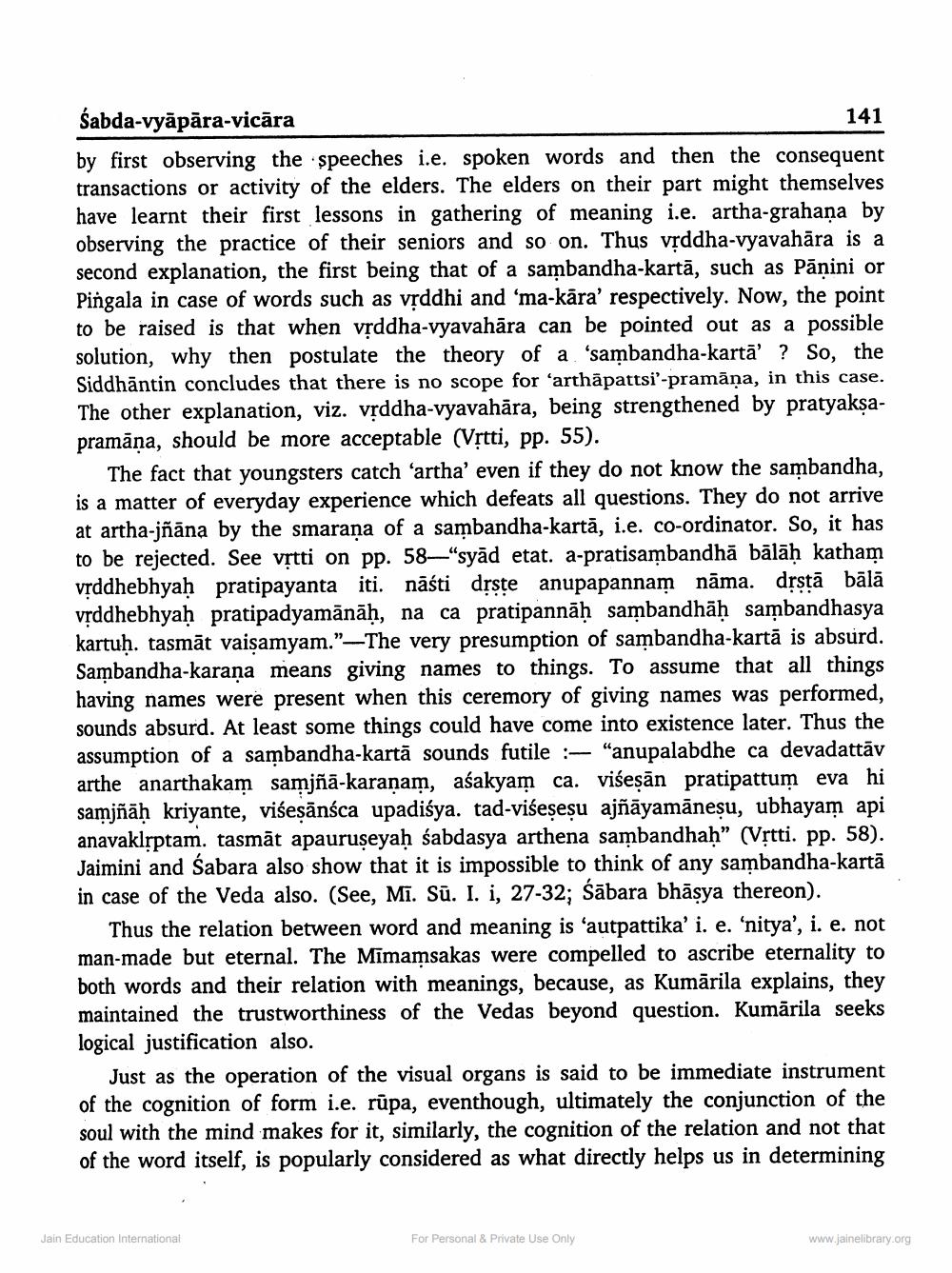________________
Śabda-vyāpāra-vicāra
141 by first observing the speeches i.e. spoken words and then the consequent transactions or activity of the elders. The elders on their part might themselves have learnt their first lessons in gathering of meaning i.e. artha-grahana by observing the practice of their seniors and so on. Thus věddha-vyavahāra is a second explanation, the first being that of a sambandha-kartā, such as Pānini or Pingala in case of words such as věddhi and 'ma-kāra' respectively. Now, the point to be raised is that when vrddha-vyavahāra can be pointed out as a possible solution, why then postulate the theory of a 'sambandha-kartā' ? So, the Siddhāntin concludes that there is no scope for ‘arthāpattsi'-pramāņa, in this case. The other explanation, viz. vrddha-vyavahāra, being strengthened by pratyakşapramāna, should be more acceptable (Vștti, pp. 55).
The fact that youngsters catch ‘artha' even if they do not know the sambandha, is a matter of everyday experience which defeats all questions. They do not arrive at artha-jñāna by the smaraņa of a sambandha-kartā, i.e. co-ordinator. So, it has to be rejected. See vștti on pp. 58—“syād etat. a-pratisambandhā bālāḥ katham vrddhebhyah pratipayanta iti. nāśti drste anupapannam nāma. drstā bālā vặddhebhyaḥ pratipadyamānāḥ, na ca pratipannāḥ sambandhāḥ sambandhasya kartuḥ. tasmāt vaisamyam.”—The very presumption of sambandha-kartā is absurd. Sambandha-karana means giving names to things. To assume that all things having names were present when this ceremory of giving names was performed, sounds absurd. At least some things could have come into existence later. Thus the assumption of a sambandha-kartā sounds futile :- "anupalabdhe ca devadattāv arthe anarthakam samjñā-karanam, aśakyam ca. viśeşān pratipattum eva hi samjñāḥ kriyante, višeşānsca upadiśya. tad-vićeșeșu ajñāyamānesu, ubhayam api anavaklịptam. tasmāt apauruseyaḥ śabdasya arthena sambandhah” (Vịtti. pp. 58). Jaimini and Sabara also show that it is impossible to think of any sambandha-kartā in case of the Veda also. (See, Mī. Sū. I. i, 27-32; Šābara bhāsya thereon).
Thus the relation between word and meaning is 'autpattika' i. e. 'nitya', i. e. not man-made but eternal. The Mimamsakas were compelled to ascribe eternality to both words and their relation with meanings, because, as Kumārila explains, they maintained the trustworthiness of the Vedas beyond question. Kumărila seeks logical justification also. Just as the operation of the visual organs is said to be immediate instrument
n of form i.e. rūpa, eventhough, ultimately the conjunction of the soul with the mind makes for it, similarly, the cognition of the relation and not that of the word itself, is popularly considered as what directly helps us in determining
Jain Education International
For Personal & Private Use Only
www.jainelibrary.org




